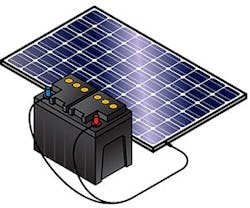Energy Storage Is Changing the Game
You have probably seen the headlines about Tesla transitioning to an “energy innovation company” and articles discussing the smart grid of the future. These events point to the writing on the wall: energy storage will play a critical role in our future. In some utility districts, the adoption of the technology is already growing rapidly as batteries are paired with solar electricity.
What does this mean for building operators? How do you take advantage of the trend?
The Solar Impact on Your Electric Bill
To estimate the potential impact on your costs, you need to examine your electric bill. Typically, bills have fixed monthly fees for service, but the majority of commercial/industrial electricity charges are made up of kilowatt (kW) charges and kilowatt hour (kWh) charges.
- kW charges (demand or power charges) are related to the maximum flow rate of energy from the utility to your facility. In some facilities, kW charges can be up to 50% of the bill!
- kWh charges (energy charges) are related to the overall quantity of energy your facility uses.
If you need more information about basic electric bill charges, there are free recorded webinars here: http://www.profitablegreensolutions.com/resources/simplified-energy-concepts-free-samples
Solar panels effectively reduce the amount of kWh (energy) you buy from the utility. However, due to solar’s intermittency (imagine a cloud passes overhead during the peak afternoon when your air conditioner is fully loaded), your facility will still draw power from the utility and you will still receive a charge for the kW.
Even though solar panel costs have dropped dramatically in the past decade, the core argument against solar from utilities is that it is an intermittent power source. That is a problem for the utility, which is trying to manage a steady flow of power on the grid. However, batteries allow solar to provide consistent power by leveling the production peaks and valleys from the sun.
Combining solar and energy storage can deliver both energy and power consistently to building operators, reducing both kW and kWh charges. Additionally, some companies offer innovative financing solutions that can package both technologies for additional advantages.
Battery Perception: Then vs. Now
In the past, energy storage (i.e. batteries) were seen as expensive and nonessential add-ons to solar installations. They required significant maintenance and rarely generated positive cash flow. The only reason to pay extra for onsite energy storage was to provide back-up power during blackouts or other unexpected electricity outages. For most companies, energy storage was seen as an expensive investment for something that might be used once a year – or even less frequently.
Today, it’s a different story – storage solutions have dropped in price and will continue to decrease as adoption grows. Along with battery cost declines, advanced energy management software now analyzes electricity usage and draws energy from the least expensive source at any given point in time.
For example, at high noon when the sun is shining and utilities charge peak rates, a facility’s energy could be drawn from the solar panels and energy storage system, reducing a company’s supply from the utility. At other times of the day, when the utility’s energy is less costly, the solar energy can recharge the batteries. By combining solar and energy storage, a building can use energy smarter and decrease the net energy cost.
Reducing Demand Charges from Equipment Startup
Traditionally, when a factory or business turns on machines, or a thermostat turns on heating and cooling systems, power usage surges to a level that’s higher than normal. Even if the power spike lasts just a few minutes, the utility will typically charge customers an additional monthly fee based on the peak kW power supplied at that moment.
To reduce these monthly demand charges, companies have to manage power surges. That’s where solar with energy storage can help both customers and utilities. Energy management software can react to these power surges (or when solar energy output temporarily dips due to a cloud) and draw energy from the batteries to smooth out the building power usage curve, thus eliminating surges. The result is a balanced utility grid and reduced demand charges for the building operator. It is easy to see that these options are good to have.
When Do Batteries Become Cost Efficient?
If you own and operate a building in California, Hawaii or New York, or in places where the average utility energy costs more than $.14/kWh (current grid parity), energy storage may already be economically feasible. For the rest of the country, a cost effective energy storage solution is likely just around the corner. These solutions most certainly will be a key piece in the smart grid of the future, so keep on the lookout!
Many thanks to Ryan Park, my long-time friend and energy advocate, who contributed most of this article. Ryan has over 15 years’ experience in the solar industry and has worked on projects all over the U.S. He can be reached at [email protected] or (805) 215-2574
---------------------------------------------------------
